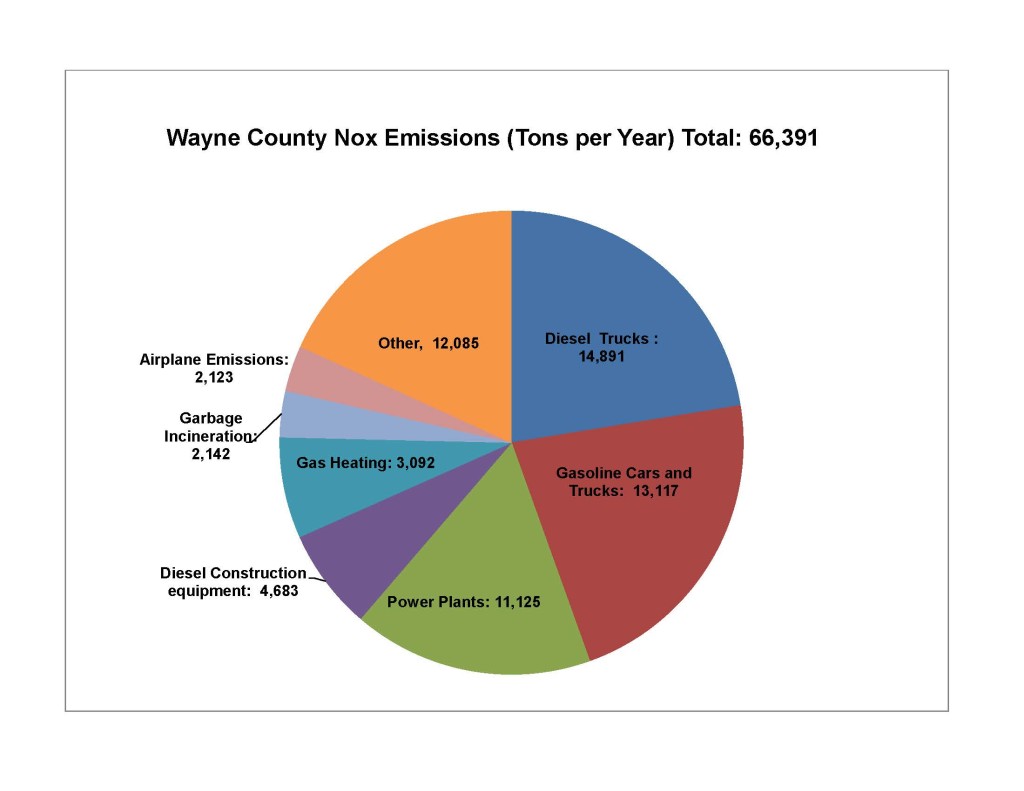Pollutant Fact Sheets
Nitrogen Oxides
WHAT ARE NITROGEN OXIDES?
Nitrogen oxides are air pollutants that contain oxygen and nitrogen with the chemical abbreviations NO and NO2. Together, they are called NOx. When fossil fuels like oil, gas, and coal are burned at high temperatures, NOx is formed. Nitrogen dioxide (NO2) is a gas with an irritating odor. It absorbs light and leads to the yellow-brown haze sometimes seen over cities. It is one of the important parts of “smog” which contains ozone, another important pollutant.1, 2
WHERE DO NITROGEN OXIDES COME FROM?
Figure 1: Emissions of NOx from major sources in Wayne County. National Emissions Inventory data, 2011.
Most NOx emissions in Detroit and southeast Michigan come from “mobile” sources, including cars, trucks, construction equipment, trains, boats, and aircraft. Other important sources include industrial and residential fuel combustion, including factory boilers, garbage incinerators, and refineries. The manufacturing industry does not account for a large part of NOx released in Detroit.3 Some of the highest levels of NOx are found near major roadways, within about 300 feet. In fact, in-vehicle levels can be much higher than levels that are measured at area-wide monitors.4 However, industrial sources also cause important local impacts.3
HOW DO NITROGEN OXIDES AFFECT YOUR HEALTH?
Studies have shown that NOx at even relatively low concentrations is associated with a variety of diseases and emergency room visits. Exposure to NOx can worsen heart disease, leading to increased hospital visits and early death.5 NOx also reacts with ammonia, water vapor, and other compounds in the atmosphere to form small particles, including PM2.5, which can enter your lungs and cause or worsen lung disease.4 NOx is also associated with:
- Reduced lung function
- Increased lung sickness
- Hospital admissions
- Lung-related emergency room visits
- Poor birth outcomes such as underweight babies6
Ongoing research is also being conducted to determine whether NOx can cause cancer.
IS DETROIT’S AIR HEALTHY?
Like most other large metropolitan areas, Detroit meets air quality standards for NOx.7 However, NOx remains important because it forms ozone, which is a problem in Detroit.8 Both the role of NOx in forming ozone and its links with other diseases highlight the importance of controlling emissions and reducing exposures. Figure 1 shows the top sources of air pollution in Detroit. People who live or spend time near to these sources of NOx may experience higher exposure than the average Detroit resident.
WHO IS MOST LIKELY TO BE AFFECTED?
Many houses, apartments, and schools are located near major highways, railroads, or airports.4 Detroit has about 80 public schools within 500 feet of major highways. People living near major roads and children attending these schools are more likely to be people of color or to be economically disadvantaged.9 This puts them in danger of higher exposure to NOx.
In addition, some people are more susceptible to the adverse effects of NOx exposure – in other words, at any given level of exposure, they have more serious health effects. People who are more likely to experience worse health effects from NOx include: young children, those over age 65, and people with existing lung diseases like asthma.5
HOW TO REDUCE AND AVOID EXPOSURE TO NITROGEN OXIDES
There are many steps that can be taken to reduce exposure to NOx:
- Avoid being near highways during peak driving hours.
- Carpool, bicycle, walk or use public transportation to reduce the volume of traffic in the city.
- Keep cars in good repair. NOx emissions may increase if your car’s “service engine” indicator is lit. Newer cars emit less NOx and so are less polluting than older cars.
- Join a community organization working to reduce pollution in Detroit (see dev-sph-caphe.pantheonsite.io for a list of organizations).
- Encourage local officials to implement strategies that limit exposure to NOx and other pollutants.
- Encourage regional and national policy and decision makers to enact and enforce legislation that promotes clean air. These actions can reduce exposure to NOx and improve health for all people.
REFERENCES
- U.S. Environmental Protection Agency, Nitrogen Dioxide, Basic Information, http://www.epa.gov/oaqps001/nitrogenoxides/, accessed 8/11/14.
- U.S. Environmental Protection Agency, Smog – Who Does it Hurt?, http://www.epa.gov/airnow/health/smog.pdf, accessed 8/11/14.
- U.S. Environmental Protection Agency, Nitrogen Oxides, Air Emissions Sources, http://www.epa.gov/cgi-bin/broker _service=data&_debug=0&_program=dataprog.national_ 1.sas&polchoice=NOX, accessed 12/18/14.
- U.S. Environmental Protection Agency, Nitrogen Dioxide, Health, http://www.epa.gov/airquality/nitrogenoxides/health.html, accessed 8/11/14.
- U.S. Environmental Protection Agency, Integrated science assessment for oxides of nitrogen, health criteria, http://cfpub.epa.gov/ncea/cfm/recordisplay.cfm?deid=194645, accessed 10/21/14.
- Le, H., Batterman, S., Wirth, JJ., et al., 2012, Air pollutant exposure and preterm and term small-for-gestational-age births in Detroit, Michigan: Long-term trends and associations, Environment International 44: 7-17.
- Michigan Department of Environmental Quality, 2013, Michigan 2012 annual air quality report, Lansing, MI: 15-16.
- Michigan Department of Environmental Quality, http://www.deqmiair.org/, accessed 4/27/15.
- Boehmer, Tegan K. et al,. Residential Proximity to Major Highways -United States, Centers for Disease Control and Prevention, http://www.cdc.gov/mmwr/preview/mmwrhtml/su6203a8.htm, accessed 10/21/14.

